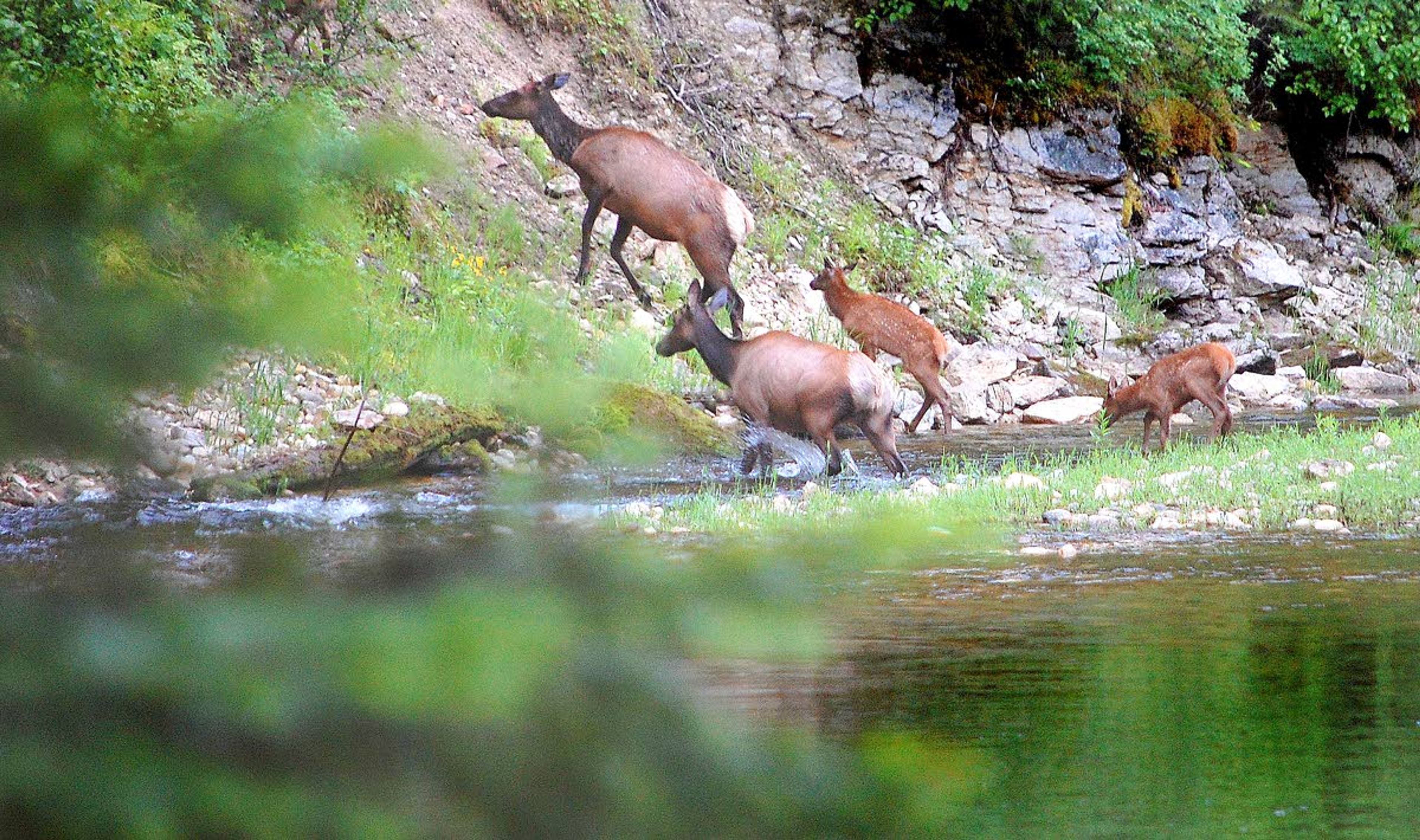Clearwater elk barely eke out a living
Population in Clearwater Region has been declining for decades; latest efforts include a field guide geared toward improving habitat
Elk in a large swath of Idaho’s Clearwater Region continue to struggle from a mix of poor habitat conditions and predation from mountain lions, black bears and wolves.
Efforts to reverse the decadeslong decline in units 10 and 12 have been going on for years now. Many are frustrated by the long dip in numbers, the economic and cultural reverberations and the seeming inability of game and land managers to implement actions on a scale large enough to effect meaningful change.
But others believe a new field guide developed by the Clearwater Basin Collaborative — which itself has been years in the making and is not quite ready to be deployed — will help agencies like the U.S. Forest Service make progress on the habitat side.
In the Lolo Zone, the progression of time has converted open brush fields into middle-aged forests that offer much lower quality forage for elk, especially during the summer months when they need to put on fat to survive the coming winter.
Predators — mountain lions, wolves and black bears — also have been identified as a problem. Much of the Lolo, along with the Selway Zone, is remote, making it difficult for wildlife managers to alter the predatory-prey balance through either hunting or control actions.
The state’s Fish and Game Commission and the Idaho Legislature have done about all they can to liberalize predator hunting and trapping regulations. But they can’t make it an easier place to hunt or trap.
“In the places we have predator management plans, the Sawtooth, Panhandle, Lolo, Selway and Middle Fork zones — those are all challenging places to get to. Some of them are challenging from the standpoint of vegetation, like in the Panhandle or remote, like the Lolo and Selway,” said Toby Boudreau, deer and elk coordinator for Idaho Fish and Game.
Last spring, the department killed 12 wolves in a control operation. Similar efforts to reduce wolf numbers in the Lolo Zone have occurred 10 of the last 11 years.
Elk numbers in the Lolo plunged from more than 15,000 animals in the late 1980s to fewer than 2,000 in 2017. Hunter effort also declined. Forest Service officials have attempted to use prescribed fire and some harvest to create pockets of younger forests and brush fields. Just this fall, the agency used prescribed fire to treat about 1,000 acres in the Cayuse Creek drainage in the upper reaches of the North Fork of the Clearwater River Basin. The effort is part of the East Saddle Integrated Restoration Program, a partnership between the Forest Service and Idaho Fish and Game.
Thus far, habitat restoration and predator management haven’t shown they are enough to restore elk numbers. People like Mike Schlegel, of Grangeville, are calling for more aggressive action.
“The excuses get old after awhile,” said the retired Fish and Game biologist and game manager. “Unless they get enough public pressure to do something, it’s not going to change.”
There have been plenty of efforts to fix the habitat. Schlegel can tick off a long list of them — the Clearwater Elk Initiative, the Clearwater Elk Collaborative and, most recently, the Clearwater Basin Collaborative.
The latest effort has funded research that will soon yield a field guide to help land managers locate prescribed burning and timber harvest projects where they stand to most benefit elk. The collaborative hired elk researchers Jon and Rachel Cook and Mike Wisdom to assess elk habitat — in terms of the presence or absence of nutritional plant species — in the Clearwater and elsewhere in Idaho. They also placed radio collars on elk to see what areas they were using and what plants they favored.
Deborah Monzingo, a Fish and Game biologist, worked on the project during graduate school. She said the forthcoming field guide covers seven different habitat zones found in the basin.
“We go from ponderosa pine stands all the way up to high-elevation spruce and fir, (with) wet and dry forest stands,” she said. “In the field guide, we discuss the preferred species for elk in each zone, what each early and late forest succession stand looks like, how old the stand is after disturbance and when the forage starts to go down.”
Zach Swearingen, habitat manager for Fish and Game’s Clearwater Region, said the guide will be a tool land managers can use when they take actions specifically aimed at improving elk habitat, as well as when they are designing timber- or fuel-reduction projects but also want to improve habitat as a secondary benefit.
“They can use it out in the field so they can identify the type plant species that are most beneficial for elk,” he said.
For Schlegel, it’s been there, done that. He said there are similar studies dating back to the 1950s that identify what needs to be done to help elk and where.
“They are just reinventing the wheel,” he said. “My main frustration is nothing has happened for 25 years and they have known for 25 years what needs to be done.”
When he says “they,” Schlegel is referring to the U.S. Forest Service. Andrew Skowlund, ranger of the North Fork District of the Nez Perce-Clearwater National Forest acknowledges altering habitat is difficult and it can take a long time.
The plants in brush fields along Kelly Creek are more than 20 feet tall in many places — too high for elk to reach. Prescribed fires, such as the 1,000 acres burned in the East Saddle project, can reset those fields and generate new growth.
To duplicate the project on a larger scale, Skowlund said the agency is working to complete environmental analysis covering vast expanses of the roadless areas across the North Fork and Lochsa districts.
“The more ground you have that is covered and cleared, the more opportunities you are going to have on any given landscape,” he said.
Having projects already through the National Environmental Policy Act process will increase opportunities for the agency to implement controlled burns when conditions are right. It also gives the agency flexibility when it comes to managing natural fires.
“We can go out and add fire to that and help it along,” he said of a hypothetical fire started by a lightning strike. “The reality is one of our biggest barriers to getting that work done and implementing it is getting the smoke clearance. So if Mother Nature starts it, we don’t have to worry as much about smoke, there is just less of a regulatory hurdle to get over when it’s a wildfire event.”
But he said the agency is always mindful of smoke. Fires in the upper North Fork often push smoke toward Missoula and the Bitterroot Valley in Montana.
“There is always a consideration of our downwind communities and what any impact of smoke is going to be,” he said. “There are people who are sensitive and I realize it has real implications for people’s health. I would rather have a little bit of smoke under our terms than the entire Bitterroot Valley socked in for months at a time when we have catastrophic wildfire conditions.”
Barker may be contacted at ebarker@lmtribune.com or at (208) 848-2273. Follow him on Twitter @ezebarker.
“My main frustration is nothing has happened for 25 years and they have known for 25 years what needs to be done.”
Mike Schlegel, retired Fish and Game biologist and game manager












